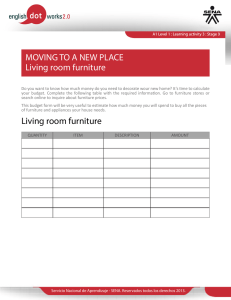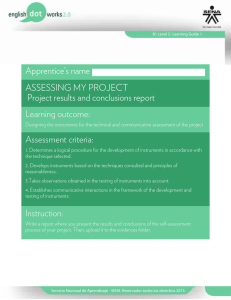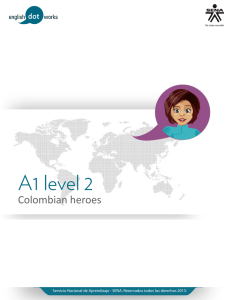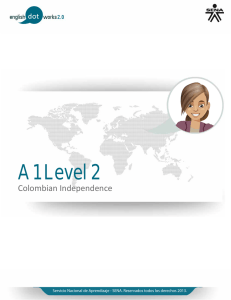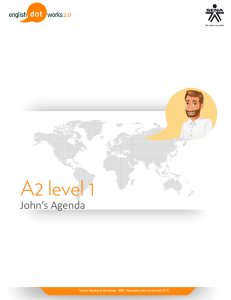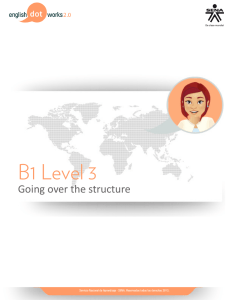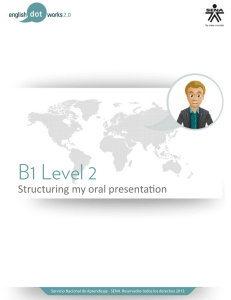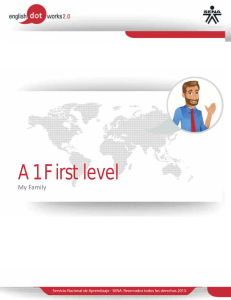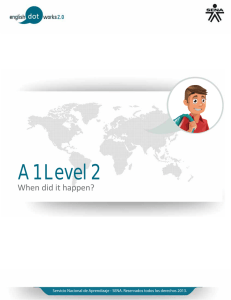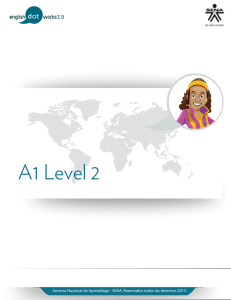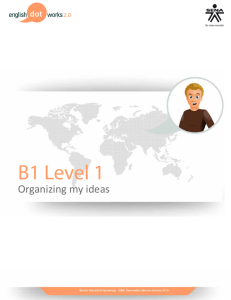B1 Second level
Anuncio
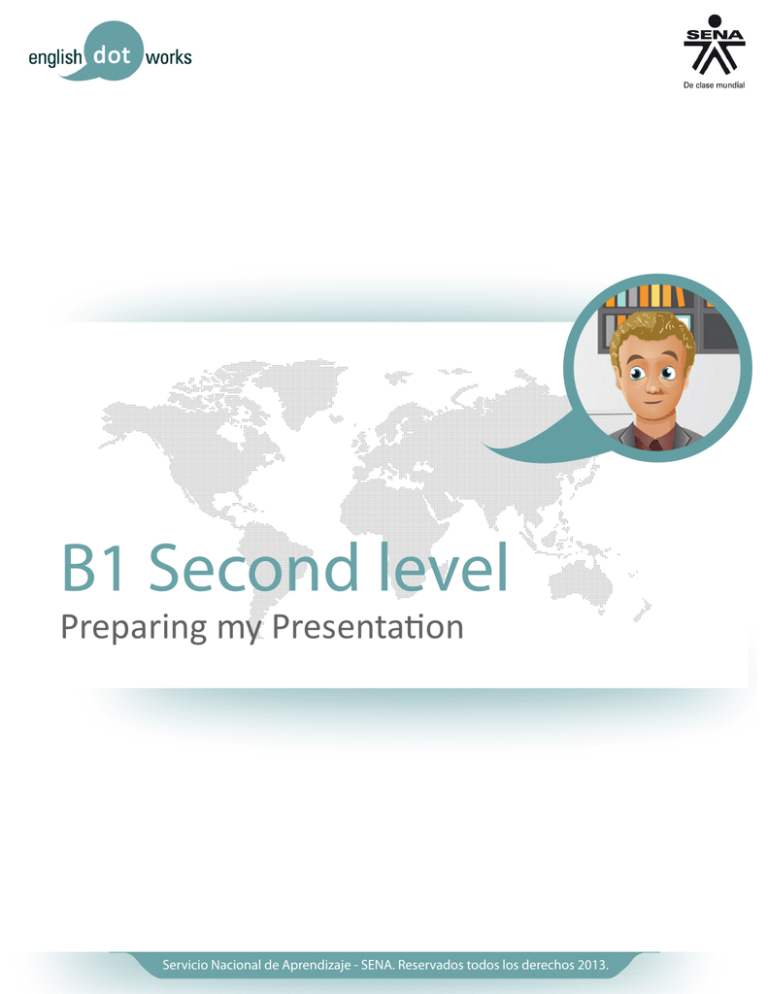
B1 Second level Preparing my Presentation Servicio Nacional de Aprendizaje - SENA. Reservados todos los derechos 2013. Start UP Welcome Welcome back dear apprentices! So far, my friend Stacey and I have looked for information about recycling, formulated our research question, objectives and forms to organize the information. Let’s review how we did that! Let’s start! Servicio Nacional de Aprendizaje - SENA. Reservados todos los derechos 2013. 2 /11 Warm up STACY: Anthony, I want to make sure you really understood everything we did with our project and you could do it again if we started a new project. So, let me ask you some questions about our project and its process. ANTHONY: Go ahead! I can remember everything you said about our project. I know that when you start researching about a topic, you need to gather many ideas until you find one that you are interested in. After that, you must put the idea in a specific context and define who will work and how to work on the idea. STACY: Very good! But, how do you narrow the topic? ANTHONY: I need to look for key concepts and I can define them in a glossary. There, I can write the function they have in the sentence or their grammatical category, write if it is a general or specialized concept, its definition , translation and the sources where I found the information about the concept. STACY: What do you do after that? ANTHONY: I need to find a question that will guide my research. This question must be clear, concise and focused on the topic I’m addressing. In order to formulate an effective guiding question, you should : choose a general topic, do preliminary research about it, narrow your topic, start asking questions, make a list of possible guiding questions, evaluate your options and choose the most suitable question. I can ask other questions that will make my research more specific. Servicio Nacional de Aprendizaje - SENA. Reservados todos los derechos 2013. 3 /11 STACY: Wow! You have become an expert in projects! ANTHONY: Oh, let’s not forget about organizing my ideas in a flowchart. They are diagrams with symbols and arrows. With a flowchart I can show the steps of a process and relations among them. Do you remember the diagram we made for our project? It’s this one! Servicio Nacional de Aprendizaje - SENA. Reservados todos los derechos 2013. 4 /11 STACY: All processes happen in a certain way. You usually follow some steps in order to achieve the best result. Imagine you are creating a glossary, a guiding question and a flow chart. Click to go from Start to Finish indicating the correct order of the steps you need to follow to work with them. Oh, dear Anthony! You can remember many things we did for our project, but you also forgot important aspects! ANTHONY: No way! What did I forget? STACY: You forgot the objectives and justifications of the project. ANTHONY: I knew it! But, how can I stop leaving aside some parts of our project? STACY: I’ll show you! Servicio Nacional de Aprendizaje - SENA. Reservados todos los derechos 2013. 5 /11 Let’s get inside STACY: In order to make sure you have included all you needed in a speech, presentation, paper, etc., you can use a checklist. ANTHONY: A checklist? I’ve heard about them but I haven’t used them. STACY: A checklist is a comprehensive list of important actions or steps to be taken in a specific order. In checklists, information must be simple, brief and effective. ANTHONY: How much information should I include in a checklist? STACY: Not much. A checklist must only contain from five to ten items, easy to remember due to their importance. ANTHONY: Do you have any other advice for me to make a checklist? STACY: Do you have any other advice for me to make a checklist? Yes, include aspects you consider priorities and write the items in such a way that you suggest a concrete action towards meeting this priority. To make sure your checklist is effective, you can use a checklist like this: Servicio Nacional de Aprendizaje - SENA. Reservados todos los derechos 2013. 6 /11 Servicio Nacional de Aprendizaje - SENA. Reservados todos los derechos 2013. 7 /11 Let’s analyze STACY: Anthony, there’s another way you can write your checklist. It doesn’t use questions but complete sentences. They are usually written in simple present. Therefore, verbs must take the characteristic –s in the third person. Take a look at the following checklist and the words highlighted. You could also write these items using present perfect since they refer to a past action being studied in the present. Servicio Nacional de Aprendizaje - SENA. Reservados todos los derechos 2013. 8 /11 References References Business Dictionary. (n.d.). Business Dictionary Online. Retrieved on October 28th 2013, from: http://goo.gl/vYYQx3 Cranston, Jane. (n.d.). Project Check Online. Retrieved on October 28th 2013, from: http://goo.gl/UMMiEY Project Check. (n.d.). Executive Coach NY. Retrieved on October 28th 2013, from: http://goo.gl/ascV9J Servicio Nacional de Aprendizaje - SENA. Reservados todos los derechos 2013. 9 /11 Credits Credits Pedagogical Direction Multimedia Development Paul Cifuentes Lina Juliana Garzón Carlos Amaya Paulo Santacruz Adriana Guerrero ICT Leadership Yeison Ospina Audio Production: David Molina Direction of Technology Wes Manuel César Páez Quality management Juan Carlos Rojas Lozada Script composition Diana Isabel Cantor Content Support Diana Isabel Cantor Servicio Nacional de Aprendizaje - SENA. Reservados todos los derechos 2013. 10 /11
